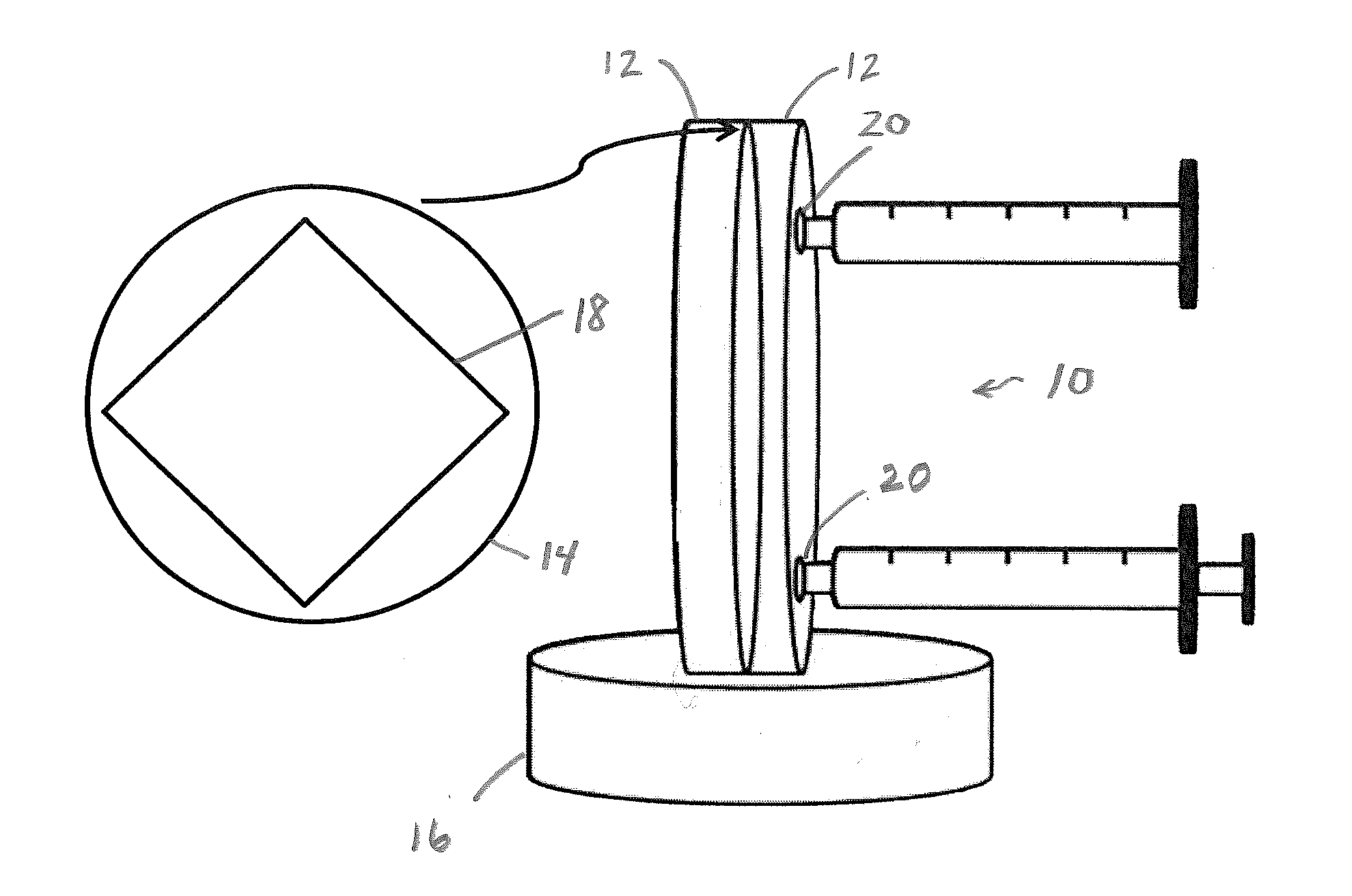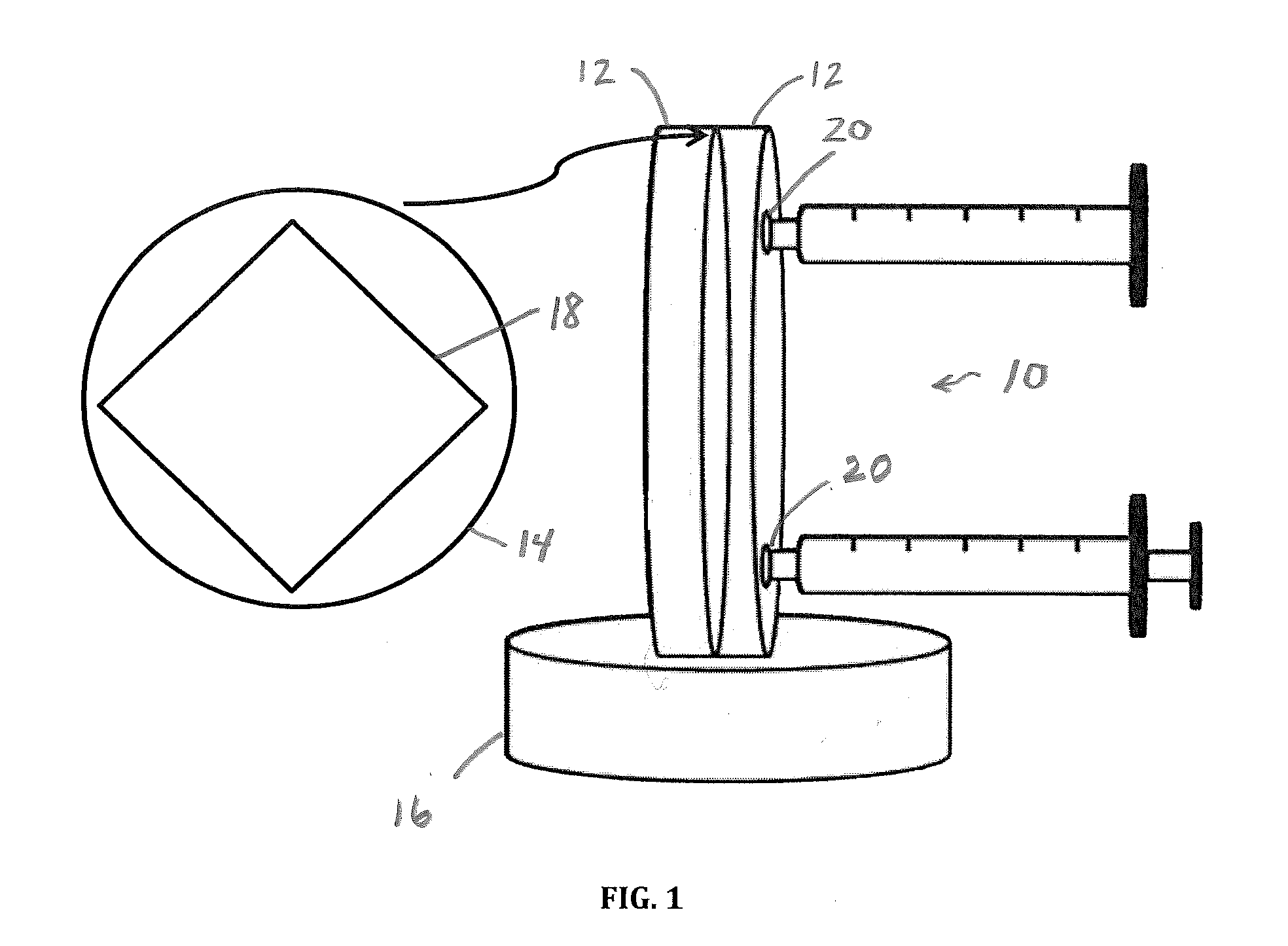Crystalline colloidal array deep UV narrow band radiation filter
a radiation filter and colloidal array technology, applied in the direction of optical radiation measurement, instruments, spectrometry/spectrophotometry/monochromators, etc., can solve the problems of inability to operate in the deep, inability to absorb uv non-absorption materials, and inability to readily be found in the uv region, etc., to achieve the effect of rejecting
- Summary
- Abstract
- Description
- Claims
- Application Information
AI Technical Summary
Benefits of technology
Problems solved by technology
Method used
Image
Examples
example 1
[0052]Charged silica particles were formed by attaching a high surface density of non UV light absorbing silane coupling agent (3-(trihydroxylsilyl)-1-propane-sulfonic acid, THOPS) to the surface of the small silica particles. A typical reaction used 5 mL tetraethoxysilane (TEOS, Fluka, Lot code 1332815 41207016) as the silica precursor, 8 mL ammonium hydroxide (29.40 wt %, J. T. Baker) as the catalyst, and 200 mL ethanol as the reaction solvent. The reaction mixture was stirred for 24 h. The resulting silica dispersion was filtered through a nylon mesh with 100 micron pore size. 200 mL of water was slowly added to the silica dispersion while stirring. The mixture was first heated to 50° C. for ˜30 min, then heated to 80° C. for ˜1 h. 6 mL of the silane coupling agent (3-(trihydroxylsilyl)-1-propane-sulfonic acid, THOPS, 30-35% in water, Gelest, Inc.) was adjusted to pH ˜6 by adding ammonium hydroxide and then added to the silica dispersion. The reaction was refluxed for 6 h at 80° ...
example 2
[0053]The Bragg diffracted wavelength of the CCA filter made from the highly charged silica particles (volume percentage 7.0%) from Example 1 can be easily tuned by changing the incident light glancing angle. FIG. 4 illustrates transmission spectra of the highly charged silica CCA filter for incident glancing angles of 90°, 69° and 66°. The band rejection wavelength can be easily tuned from 237 nm to 227 nm by tilting the filter with respect to the incident beam as shown in FIG. 4. The full bandwidth, indicated by these measurements, is 6 nm to the 50% transmittance points and 1 nm to the 15% transmittance points for normal incidence. This measured full bandwidth is broader than the true CCA bandwidth because the absorption spectrophotometer used has a weakly focused sampling beam. The full bandwidth to the 50% transmission points determined by a Teflon Raman measurement is only 4 nm. For a Rayleigh rejection filter, only half full bandwidth is involved in the long wavelength pass f...
example 3
[0054]The highly charged silica CCA filter from Example 2 can be used to reject Rayleigh scattered light in UV Raman spectral measurements. A Teflon film was used as the sample for the Raman measurements. Raman spectra were excited with the 229 nm line (2 mW) from a continuous-wave UV Ar laser (Innova 300 FReD, Coherent Inc.). The schematic of the triple-stage monochromator and the CCA filter for Raman measurements for one embodiment is shown in FIG. 5. The spectrometer premonochromator 28 (illustrated as a double monochromator) having a bandpass slit 30 and gratings 32) was aligned to block most of the Rayleigh scattered light to avoid saturating the CCD camera 34. The embodiment shown has an entrance slit 36 and additional gratings 38. All optical elements of the spectrometer were identical for Raman spectra measured in the absence and presence of the CCA filter 40. The CCA filter 40 was placed between a collection 42 and imaging lens 44 where the light is collimated. Raman spectr...
PUM
| Property | Measurement | Unit |
|---|---|---|
| diameter | aaaaa | aaaaa |
| diameter | aaaaa | aaaaa |
| wavelength | aaaaa | aaaaa |
Abstract
Description
Claims
Application Information
 Login to View More
Login to View More - R&D
- Intellectual Property
- Life Sciences
- Materials
- Tech Scout
- Unparalleled Data Quality
- Higher Quality Content
- 60% Fewer Hallucinations
Browse by: Latest US Patents, China's latest patents, Technical Efficacy Thesaurus, Application Domain, Technology Topic, Popular Technical Reports.
© 2025 PatSnap. All rights reserved.Legal|Privacy policy|Modern Slavery Act Transparency Statement|Sitemap|About US| Contact US: help@patsnap.com



